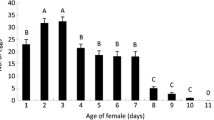Abstract
Food consumption and utilization by the hosts (Porthesia scintillans, Spodoptera exigua) decreased when they were parasitized by a gregarious and a solitary parasitoid (Apanteles flavipes, A. prodeniae). Larval duration of the parasitizedP. scintillans extended to 15.8 days compared with 12.6 days for the unparasitized host. Relative to unparasitized hosts, the host parasitized by the gregarious parasitoid consumed 28% less food during the entire larval period and that parasitized by the solitary parasitoid consumed 94.4% less food.
Similar content being viewed by others
References
Beckage NE, Riddiford LR (1983) Growth and development of the endoparasitic waspApantles congregatus: dependence on host nutritional status and parasitic load. Physiol Entomol 8:231–241
Dout RL (1959) The biology of parasitic hymenoptera. Ann Rev Entomol 4:161–182
Dout RL (1963) Pathology caused by insects. In: Steinhaus EA (ed) Insec pathology: an advanced treatise, vol II Academic Press, New York, pp 393–422
Guillot FS, Virlson SB (1972) The role of calyx and poison gland ofCardiochiles nigriceps in the host parasitoid relationship. J Insect Physiol 18:1315–1321
Guillot FS, Vinson SB (1973) Effect of parasitism byCardiochiles nigriceps on food consumption and utilization byHeliothis virescens. J Insect Physiol 19:2073–2082
Hubner LB, Chiang HC (1982) Effects of parasitism byLyxophaga diatroea (Diptera: Tachinidae) on food consumption and utilization of European corn borer larvae (Lepidoptera Pyralidae). Environ Entomol 11:1053–1057
Hunter KW, Stoner A (1975)Copidosoma truncatellum: effect of parasitization on food consumption of larvalTrichoplusia ni. Environ Entomol 4:381–382
Jones RL, Lewis WJ (1971) Physiology of the host-parasite relationship betweenHeliothis zea andMicroplitis croceipes. J Insect Physiol 17:921–927
Muthukrishnan J, Pandian TJ (1987) Insecta. In: Vernberg FJ, Pandian TJ (eds) Animal energeties, vol I. Academic Press, New York, pp 373–511
Muthukrishnan J, Senthamizhselvan M (1987) Effect of parasitization byApanteles flavipes on the biochemical composition ofDiacris obliqua. Insect Sci Appl 8:235–238
Muthukrishnan J, Senthamizhselvan M (1988) On certain correlations between host parameters and parasitoid production. Ann Entomol 2:7–10
Parker FD, Pinnell RE (1973) Effect of food consumption of the imported cabbageworm when parasitized by two special ofApanteles. Environ Entomol 2:216–219
Petrusewiez K, Macfadyen A (1970) Productivity of terrestrial animals. Principles and methods. Blackwell Oxford, p 190
Rahman M (1970) Effect of parasitism on food consumption onPieris rapae larvae. J Econ Entomol 63:820–821
Schmidt JM, Smith JJB (1985) Host volume measurement by the parasitoid waspTrichogramma minutum: the role of curvature and surface area. Eptomol Exp Appl 39:213–221
Senthamizhselvan M (1987) Physiological studies on chosen insect pests, predators and parasitoids. Ph.D. Thesis, Madurai Kamaraj University. Madurai, p 192
Senthamizhselvan M, Murugan K (1988) Bioenergetics and reproductive efficiency ofAttractomarpha crenulata (Orthoptera) in relation to food quality. Proc Indian Acad Sci 97:505–519
Senthamizhselvan M, Muthukrishnan J (1988) Interspecific differences in the host plant utilization of coexisting lepidopteran larvae. Proc Indian Natl Sci Acad 54:307–314
Slansky F Jr (1978) Utihzation of energy and nitrogen by larvae of the imported cabbageworm,Pieris rapae, as affected by parasitism byApantles glomeratus. Environ Entomol 7:179–185
Smilowitz Z, Iwantsch GF (1973) Relationships between the parasitoidHyposoter exiguae and the cabbage looper,Trichoplusia ni: effects of host age on developmental rate of the parasitoid. Environ Entomol 2:759–763
Smith CL, Smilowitz Z (1976) Growth and development ofPieris rapae parasitized byApanteles glomeratus. Entomol Exp Appl 19:189–195
Vinson SB (1975) Biochemical coevolution between parasitoids and their hosts. In: Price P (ed) Evolutionary strategies of parasitic insects and mites. Plenum Press. New York, pp 14–48
Vinson SB, Barras DJ (1970) Effects of the parasitoid,Cardiochiles nigriceps, on the growth, development and tissues ofHeliothis virescens. J Insect Physiol 16:1329–1338
Vinson SB, Iwantsch GF (1980) Host regulation by insect parasitoids. Q Rev Biol 55:143–165
Waldbauer GP (1968) The consumption and utilization of food by insects. Adv Insect Physiol 5:229–288
Wyile HG (1967) Some effects of host size onNasonia vitripennis andMuscidifurax raptor (Hymenoptera: Pteromalidae). Can Entomol 99:742–748
Author information
Authors and Affiliations
Rights and permissions
About this article
Cite this article
Senthamizhselvan, M., Muthukrishnan, J. Effect of parasitization by a gregarious and a solitary parasitoid on food consumption and utilization byPorthesia scintillans Walker (Lepidoptera: Lymantriidae) andSpodoptera exigua Hubner (Lepidoptera: Noctuidae). Parasitol Res 76, 166–170 (1989). https://doi.org/10.1007/BF00930840
Accepted:
Issue Date:
DOI: https://doi.org/10.1007/BF00930840




